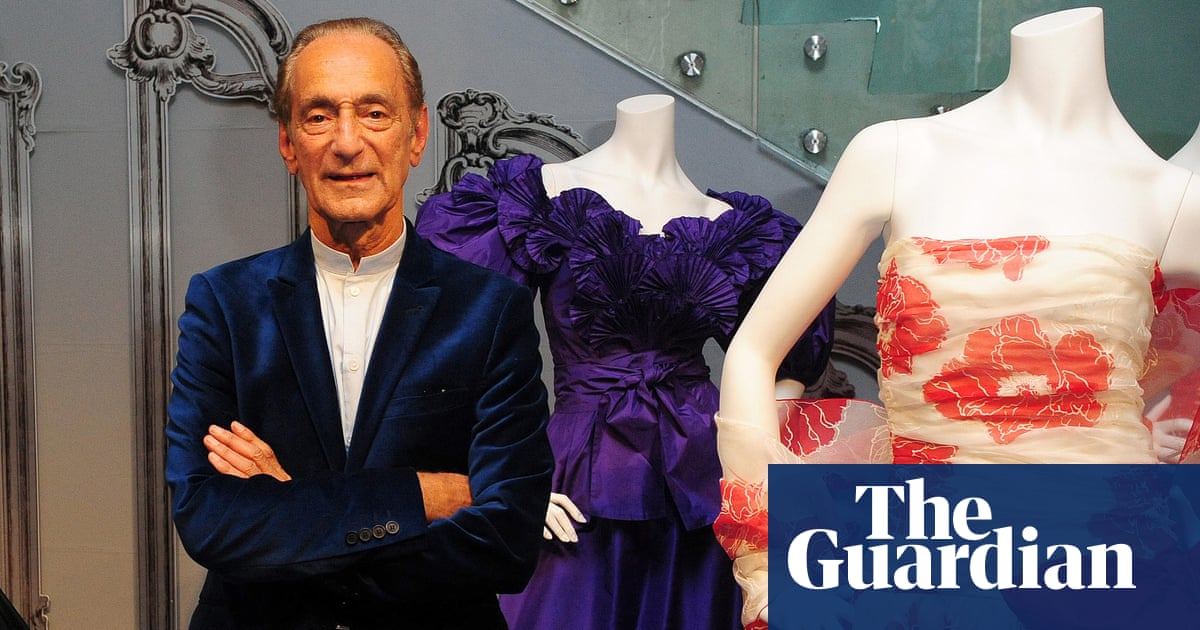Belinda Bellville, a designer of special occasion clothes for her own wealthy, well-connected social group, was pregnant in 1958 and in urgent need of a temporary assistant in her London atelier. She found David Sassoon, a Royal College of Art student, and offered him a job after seeing his degree show. Bellville was old-style class, Sassoon was the new meritocracy, and what became their joint firm, Bellville Sassoon, succeeded for over half a century.
Sassoon, who has died aged 92, recalled how Bellville inducted him to her strata. She taught him how those attending the royal enclosure at the Royal Ascot race meeting, a highlight of the social season, pronounced “Ascot” – with very clipped vowel sounds. She explained how to be patient with clients’ non-model figures, and age and status fears, made introductions and led him through the Buckingham Palace tradesman’s entrance to fit the young Princess Anne with a bridesmaid’s frock, Bellville’s first royal commission. Following etiquette, Sassoon stepped backwards away from Queen Elizabeth II and put his foot in the corgis’ water bowl.
It never mattered. Bellville and her customers respected Sassoon’s attentiveness and inventiveness: he became a couturier in the original sense of the word, directly creating clothes for prestigious customers, providing a balance of modishness with personal requirements. His reticent outsider identity endeared him to his major patron, Diana, Princess of Wales. Her customer experience did not begin well – before her wedding to Prince Charles in 1981 Diana presented herself tentatively at Bellville Sassoon’s Knightsbridge premises, where an unimpressed saleswoman suggested she try Harrods. Then her mother,Frances Shand Kydd, escorted her back to order a 10-dress trousseau. Sassoon designed the newlywed Princess of Wales’s going-away outfit, and confected a matching pochette bag because she had forgotten to buy a handbag.
He wrote a good luck note and tucked it inside; she found that a comfort in a nervous moment, and their collusion over her appearance was on, continuing for more than 70 outfits. Sassoon made the princess’s wishes happen and she trusted his judgment. Among the many royals Sassoon dressed (British, European and Gulf), Sarah, Duchess of York, fancied the outrageous and wore it against all advice, he said, while Princess Margaret had no more care for her wardrobe than for people.
Audrey Hepburn, Jackie Kennedy, Elizabeth Taylor, Helen Mirren, Jerry Hall, Madonna and many others wanted unique outfits for gala events through the good times of the 1960s and 70s, and into the 80s. These were a different genre of display from post-1990s red carpet gowns: in the earlier era, celebrities did not do a lot of static posing, so gladrags had to be wearable through active nights of partying, dancing, and going to the loo, without assistants on hand to rearrange the drapery afterwards.
The name on the labels (which changed from Bellville et Cie to Bellville Sassoon in 1970, when she invited him to be a partner) never had to flaunt brand identity as the company avoided paid-for publicity or advertising. Its workrooms, staffed with cutters, stitchers and finishers, attracted all the customers it could cope with through personal introductions. Ready-to-wear, which it produced from the 60s on, was first sold to existing regular customers who wanted something new in a hurry.
Those of Sassoon’s clientele who were artists, performers or collectors, plus Bellville herself, appreciated Sassoon’s cultural depth. His ideas were inspired by a wide knowledge of applied and fine arts: a coat hand-painted with flowers from a Mughal miniature; a silk crepe dress handsmocked in Arts and Crafts style; a state-banquet gown hand-beaded with Wedgwood cameos. He attributed his endless curiosity about decoration to his family.
His parents, Victoria and Gourgi Sassoon, were a Sephardic Jewish couple from Iraq who honeymooned in London in 1925 and never went back to Baghdad. They set up a home, in Highbury, London, rich with colour and art. David was the third of their six children, interested enough in clothes to doll up his younger sister in remnants from his mother’s trousseau. He wanted to be an actor, and after finishing boarding school and Avigdor high school in Stoke Newington, got a scholarship to study at Rada.
But his father begged him to pursue a more secure future, so he first went to Chelsea College of Art and, after national service with the army in Egypt, won a scholarship to the Royal College of Art fashion department, where he studied under its revolutionary professor Janey Ironside. He enjoyed acquiring the technical competency she insisted on.
Some of his student contemporaries became famous for imaginative ready-to-wear in the boutiques that dominated in the 60s, while Sassoon at Bellville et Cie anonymously clothed the best to Paris standards, albeit with London bohemian vibes. He teased Bellville that he had brought her a dowry of clients from his own Jewish milieu, eager to dress up for bar mitzvahs and weddings – couture bridal gowns were always the firm’s steady, secure, income.
Bellville retired in 1981, and handed over the firm to Sassoon, who recruited Lorcan Mullany, particularly for ready-to-wear designs, which were crucial from the 1990s, as couture dwindled because clients grew time-poor: two hours for a fitting had become a luxury. Sassoon worked on, also in ready-to-wear, until 2012.
His lasting affection, though, was for his couture creations – in 1978, he had paid the ransom for a collection stolen from a show in New York, personally buying back one dress from a drag queen in Harlem. In retirement, he coaxed loans of his favourites from their owners for an exhibition, The Glamour of Bellville Sassoon, at the Fashion and Textile Museum in 2013, arranging them in gossipy groups. His work also starred in the exhibition Fashion City: How Jewish Londoners Shaped Global Style at the Museum of London Docklands in 2023.
David Sassoon, fashion designer, born 5 October 1932; died 9 April 2025
